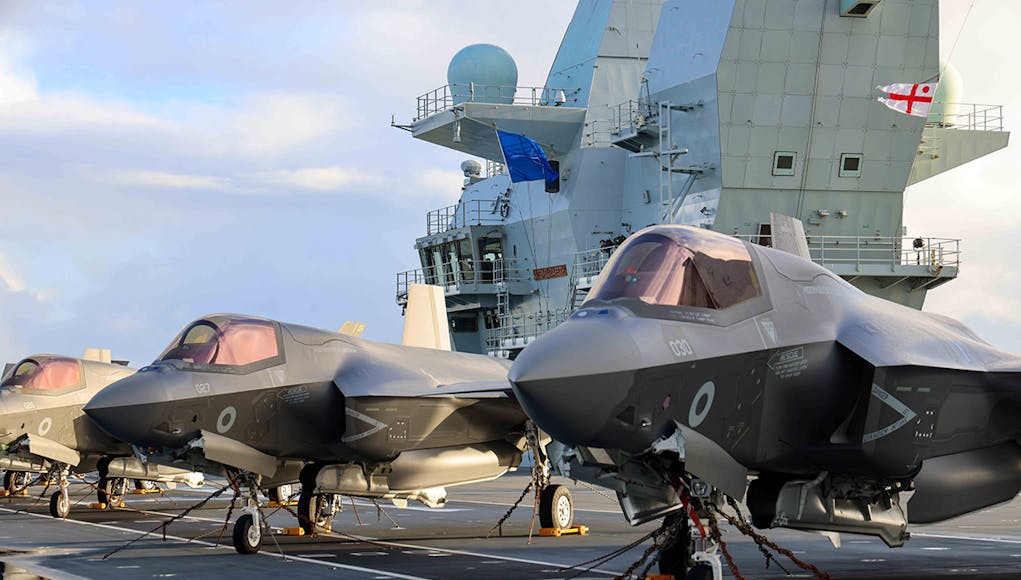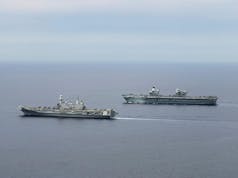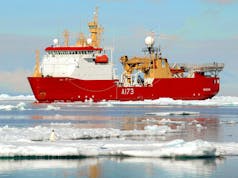HMS Queen Elizabeth, the flagship of the Royal Navy and the UK’s most powerful warship, is under NATO command for the first time.
This milestone was announced via a NATO tweet, which underscored the deployment of the British aircraft carrier alongside allied forces for the #NeptuneStrike exercise.
HMS Queen Elizabeth, @RoyalNavy’s largest and most powerful ship ever built, sails under NATO command for the first time.
The 🇬🇧 aircraft carrier & carrier strike group is deployed alongside Allies for #NeptuneStrike, demonstrating NATO’s ability to protect and defend against… pic.twitter.com/8FXBOc8OCm
— NATO (@NATO) November 9, 2023
The Royal Navy said in a statement:
“Control of HMS Queen Elizabeth and the UK Carrier Strike Group (UKCSG) comprised of frigate HMS Kent, destroyer HMS Diamond, aircraft, including F-35B Lightning jets, Wildcat and Merlin helicopters, and support ships was transferred to NATO to create a potent task group able to operate across a vast area from the length and breadth of the Mediterranean and north to the Baltic Sea.
Three aircraft carriers have been under NATO’s command – with the UKCSG deployed to the North Sea, the Italian ITS Cavour and Spanish ESP Juan Carlos in the Mediterranean – knitting together cutting-edge forces ready to shield every inch of the alliance’s airspace, waterways and territory.
Warships from 21 nations are deployed on the exercise – codenamed Neptune Strike – and are under the command and control of NATO’s Naval and Striking Support Forces, a battle staff under the Supreme Allied Commander Europe tasked with rapidly planning and executing operations wherever needed.
Neptune Strike is ‘enhanced vigilance activity’ – basically showing that NATO remains as strong and relevant as ever and capable of the defensive commitments of the alliance.
When any Royal Navy ship and its crew is under NATO command it is carrying out duties of vital importance to the alliance for a set period as part of the nation’s staunch commitment to the security of its allies and partners. Once that operation is complete – or when UK requirements demand – the ships returns to RN control for further tasking.”
Commodore James Blackmore, Commander of the UK’s Carrier Strike Group, said:
“Deterrence and defence of the Euro Atlantic is at the heart of NATO, and our enhanced vigilance activity with Neptune Strike is a clear demonstration of that. This is the first time a UK Carrier Strike Group has been commanded by NATO in my memory, so this is momentous for the UK and the alliance. I look forward to a full week of activity ahead, and much more in the future; we are stronger together.”
What is the Carrier Strike Group doing?
The UK Carrier Strike Group, led by flagship HMS Queen Elizabeth, recently completed the first phase of its autumn deployment. This involved participating in a series of simulated strike missions in the North Sea and Norwegian Sea alongside international naval partners.
“HMS Queen Elizabeth and her embarked jets and helicopters have proven their ability to provide the “punch” of the UK Carrier Strike Group during a series of simulated strike missions alongside international partners”, the press release stated.
Joining the aircraft carrier for these combat simulations were several ships from the UK and allied nations. Among these were the Type 45 destroyer HMS Diamond, Royal Fleet Auxiliary tanker RFA Tideforce, Norwegian ships HNoMS Otto Sverdrup and HNoMS Maud, Dutch ships HNLMS De Zeven Provincien and HNLMS Van Amstel, and the Belgian frigate BNS Louise Marie.
The exercises featured HMS Queen Elizabeth’s F-35 Lightning fighter jets from 617 Squadron, Merlin helicopters from 820 Naval Air Squadron, and Wildcat helicopters from 815 and 847 Naval Air Squadrons. Their missions varied, ranging from defending against aerial threats to suppressing enemy air defences and executing strike attacks.
Additionally, HMS Queen Elizabeth and her Carrier Strike Group showcased their medical capabilities, including advanced resuscitation techniques, trauma surgery, and casualty evacuations.
The next phase of the deployment will feature UK forces collaborating with ships and personnel from Joint Expeditionary Force (JEF) nations, which include countries such as Denmark, Estonia, Finland, Latvia, Lithuania, the Netherlands, Norway, and Sweden.
Commodore James Blackmore, Commander of the UK Carrier Strike Group, was quoted as saying, “CSG23 is off to a great start. Integrated training within the air and maritime environments, and alongside our European allies, has demonstrated the capability and agility of UK Carrier Strike.”
“Integrated training within the air and maritime environments, and alongside our European allies, has demonstrated the capability and agility of UK Carrier Strike”, reaffirmed Blackmore.














How can she possibly be NATO command ship in the North Atlantic without 100 F18’s onboard. OMG carriers with out planes again. I wonder if anyone in Italy and Spain are lamenting their apparent lack of aircraft on carriers.
Given the actual threat to Europe from the sea which is almost entirely under sea I might suggest QE class to be the perfect aviation asset and command ship for NATO abut I’m sure someone will come along to tell us that helicopters are not aircraft again soon. 😀
Not sure why we need carriers in the North Sea, its easily covered from land bases and IFR. Carriers come into their own when you need to project power 1000s of miles away not tens or hundreds. If we’re going to end up patrolling these waters with F35s then better switch to land bases and the F35A gain 120m miles more combat radius, 3000lbs more loadout and save $30m an airframe. Shedding the carriers also frees up escorts to patrol and protect North Sea Assets. I’m not pro getting rid of the carriers but if we’re going to be Europe and North Atlantic focused then there’s little logic in retaining carriers. I think future defence reviews with be very interesting.
It’s an Exorcise though, just valuable training for all concerned…… just like CSG to the Western Pacific/SCS. .
But will that always be the case, we will have new government in around 1 year who have different priorities and plans for defence. Pacific isn’t one of them.
Yes, it will always be the case that we Exorcise with other navy’s and Nato whenever and wherever the need is required. I don’t really do politics though so I don’t follow the rubbish that is caused.
Possibly Russia first strikes nato airfields. We’re just letting Russia know we got options.
So why doesn’t the rest of Europe have carriers
And if no land bases are available to use to utilise that amazing extra 120 mile range what then?
A brilliant guy called Cobham invented in-flight refueling. And if this us such a yes concern then every European nation should have carriers. Besides I’m for keeping the carriers but the next government is going want to be far less global thinking. I’m presenting logical argument that if we’re less global then carriers are not required and we could invest in ifr, we’re already flying Typhoon from roads of which there’s 1000s of miles of in the UK.
The RN needs to be international in its outlook, the AUKUS alliance will mean semi regular carrier deployments to the Indo Pacific, a Carrier task group that trains with the Australians, USN and in the future, works closely with the Japanese, including no doubt cross deck training will send a clear message to China that the UK is re-engaging in that area
Also, the QE Class will be important NATO assets in the Atlantic, perhaps focusing more on being part of an anti Submarine task group, or deployed off Norway, or in the Med, were they could well play a pivotal NATO role in deploying air power if another Libya type scenario occurs, perhaps embarking Italian F35B’s too.
They have the size and impressive C4 facilities to deploy a large tailored air group, that gives them great flexibility as national and NATO assets.
As the ships and their air groups mature and we add various UAV assets, plus cross deck other NATO nations assets when called for, they will prove a unique and sought after capability.
I’m not disagreeing but the RN has to dance to the tune of the government of the day. I think the government will be looking very long and hard at these assets and asking do we need them. We’re more likely to align with a European defence posture and I can count on 1 finger the European countries that have serious carrier capabilities. imo there little logic in the next government keeping them. Hopefully I’m proven wrong but only time will tell.
Depends. The need for an Aircraft carrier to assist in Subhunting operations was noted a long time ago in the North Sea and North Atlantic, that’s why the Invicibles were built, even when the UK was aiming at being a “close to home” power. Granted, that particular capability is more about being able to support and deploy helicopters than F-35’s but still, if for example you want to Patrol the GIUK Gap, an F-35A is not going to have the Range to cover you, you’re going to want a carrier based fighter in case a Russian strategic bomber gets ideas.
We now have decent deck/hanger space on the T45, T31 and T36 it’s more cost effective use 2or 3 of these assets with Merlins than carrier stike group. Range of tge F35 can be increase through ifr. Invest in some MQ25s will provide stealthy ifr otherwisewe have MRTT. We tested Typhoons from road so no reason why the F35A couldn’t. If I’m a government bean counter and I want to increase spend in Europe and save elsewhere what are you going to cut? And if I cut it, can something else fill the gap or 90% of that gap then that cut will probably happen.
So you’re somehow going to provide fighter cover to a subhunting group beyond the range of F-35’s as they patrol the GIUK gap… that’s not going to happen. As I said there’s a reason that even the North Atlantic focused RN of the 1970s felt it was going to need carriers to support it’s task forces, with fighters on board. It’s simply not in range of the UK. (No idea why you’re talking about Roads, I didn’t mention roads). And this is BEFORE we ever talk about sailing beyond the GIUK gap, which we do, and will. So no, cutting the carriers, which I think your arguing for, will not fill a gap that can be “90%”ed by other assets, and you’re talking to an Army first girl.
BTW, a “hanger” is something you put your jacket on, a hangar is a place you leave your plane.
Good logic Dern. We can see why the RN went the way of the Invincible carriers in the 80s re the GIUK gap. I’m sure the Admiralty would have much preferred the Ark Royal and Eagle option though!
I think they where just happy to get to keep their through deck cruisers and p*ss with the urethra they had. 😅
To be fair Expat, we have no idea what mayhem the next mob to occupy 10 might do with defence, nothing is ever safe and we all know that.
That said, for the reasons I’ve mentioned, the QE Class have a huge amount of capability to offer NATO in the future and as a flexible sovereign UK asset.
I do suspect that once the evaluation and full working up of the class has been accomplished, we will be looking at only one operational, with the other in refit or reserve.
It’s unfortunately low hanging fruit for cuts.
Are you ok hun ?
Better now 😀
NATO is an alliance.
If NATO, with an American commander, needs a local carrier he will look at a QEC or CdG (if France is in NATO that week or is it Tuesdays and Thursdays only?).
If needs be the American NATO colander would request USMC jets via the usual channels.
Whatever escorts are required will be drawn for the available NATO allocated pool.
Agree this is what makes QE so good, it can take aircraft from a wide variety of allied nations including helicopters and F35’s.
You might be able to land an F18 on CDG or a Rafael on a Nimitz on a one off basis but operating cross deck is very difficult and would require massive amounts of training and work up.
Japan, Italy, Singapore and the USA can all put jets on QE class straight away and could probably begin operations in a short space of time as they are operating identical aircraft that land themselves on the deck.
We already did this with the USMC and I hope we take the opportunity to do it with Singapore and Japan next time the CSG is out there.
Isnt it time for a proper RN presence at RIMPAC again, rather than a General Staff ?
Absolutely, cross decking will be a big part of their operational lives.
You can hypothersise in the near future a RN task group, taking on escorts from all over SE Asia, with the QE class taking on board Japanese, USMC and Singaporean B’s for a few weeks and carrying out joint regional exercises.
It’s absolutely the way to go and sends a clear message to China.
France declares CdG to NATO on Tuesdays and Thursdays, but with a mandatory two hour lazy lunch and wine and cheese on the flight deck in the afternoons….
Joking aside, I’ll bet the food on board is excellent 👌
It wasn’t the afternoon I spent on-board her. ☹️
Just a minor point but there is little doubt that the nuclear ballistic missile armed subs of the Vanguard class are the UK’s most powerful warships. Instant sunshine -accept no substitutes.
And today the Astutes with Spearfish and Tomahawk are probably the most powerful conventionally armed vessels. QE, once the F35s get their SPEAR3, in several years time, may take that mantra.
By far!